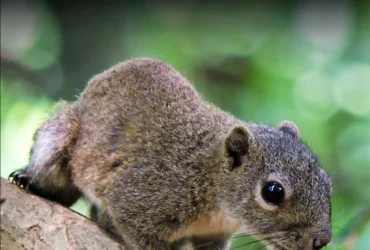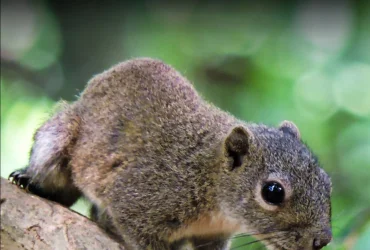Volume 10 | Number 1 | May 2021
 v10i1.244
v10i1.244ISSN: 1800-427X (printed)
eISSN: 1800-427X (online)
DOI:10.47605/tapro.v10i1.244
Submitted date: 15 March 2021
Accepted date: 10 May 2021
Published date: 27 May 2021
Pp. 4–22, pls. 1–2.
A NEW SPECIES OF THE GENUS Tylototriton (AMPHIBIA, CAUDATA, SALAMANDRIDAE) FROM CENTRAL VIETNAM
Nikolay A. Poyarkov*, Tan Van Nguyen & Dmitriy V. Arkhipov
*Corresponding author. E-mail: n.poyarkov@gmail.com
Abstract
We describe a new species of the genus Tylototriton from Pu Hoat Nature Reserve, Nghe An Province, in the northern part of Central Vietnam, based on morphological and molecular evidence. The new species was previously confused with T. vietnamensis from northern Vietnam and T. notialis from Laos. The new species can be distinguished from T. notialis by the absence of orange coloration on posterior end of parotids (vs presence); an indistinct brown coloration on rib nodules (vs bright orange); a broader and slightly rounded head (vs narrower and angular); comparatively shorter limbs (vs longer); slightly fewer number, smaller size and irregular arrangement of rib nodules (vs larger rib nodules arranged in two dorsolateral series). Phylogenetic analysis of the ND2 and 16S rRNA mtDNA genes confirmed the placement of the new species to Clade I of the subgenus Yaotriton, and suggests it is a sister species of T. notialis (p-distance 3.0% in ND2 gene). The range of the new species is restricted to the Pu Hoat Mountain Range and is isolated from the range of T. notialis, which inhabits Northern Annamites (Truong Son) Mountains by the valley of the Ca River, an important biogeographic barrier. The new species is currently known only from the montane forests of Pu Hoat Nature Reserve (at elevations from 700 to 1000 m a.s.l.). We suggest the new species be classified as Endangered (EN) on the IUCN Red List.
Key words : Tylototriton thaiorum sp. nov., mtDNA genealogy, Pu Hoat Nature Reserve, Ca River
Section Editor: Thasun Amarasinghe
LSID:urn:lsid:zoobank.org
eISSN: 1800-427X (online)
DOI:10.47605/tapro.v10i1.244
Submitted date: 15 March 2021
Accepted date: 10 May 2021
Published date: 27 May 2021
Pp. 4–22, pls. 1–2.
A NEW SPECIES OF THE GENUS Tylototriton (AMPHIBIA, CAUDATA, SALAMANDRIDAE) FROM CENTRAL VIETNAM
Nikolay A. Poyarkov*, Tan Van Nguyen & Dmitriy V. Arkhipov
*Corresponding author. E-mail: n.poyarkov@gmail.com
Abstract
We describe a new species of the genus Tylototriton from Pu Hoat Nature Reserve, Nghe An Province, in the northern part of Central Vietnam, based on morphological and molecular evidence. The new species was previously confused with T. vietnamensis from northern Vietnam and T. notialis from Laos. The new species can be distinguished from T. notialis by the absence of orange coloration on posterior end of parotids (vs presence); an indistinct brown coloration on rib nodules (vs bright orange); a broader and slightly rounded head (vs narrower and angular); comparatively shorter limbs (vs longer); slightly fewer number, smaller size and irregular arrangement of rib nodules (vs larger rib nodules arranged in two dorsolateral series). Phylogenetic analysis of the ND2 and 16S rRNA mtDNA genes confirmed the placement of the new species to Clade I of the subgenus Yaotriton, and suggests it is a sister species of T. notialis (p-distance 3.0% in ND2 gene). The range of the new species is restricted to the Pu Hoat Mountain Range and is isolated from the range of T. notialis, which inhabits Northern Annamites (Truong Son) Mountains by the valley of the Ca River, an important biogeographic barrier. The new species is currently known only from the montane forests of Pu Hoat Nature Reserve (at elevations from 700 to 1000 m a.s.l.). We suggest the new species be classified as Endangered (EN) on the IUCN Red List.
Key words : Tylototriton thaiorum sp. nov., mtDNA genealogy, Pu Hoat Nature Reserve, Ca River
Section Editor: Thasun Amarasinghe
LSID:urn:lsid:zoobank.org
 v10i1.243
v10i1.243ISSN: 1800-427X (printed)
eISSN: 1800-427X (online)
DOI:10.47605/tapro.v10i1.243
Published date: 27 May 2021
Pp. 1–3
EDITORIAL : Covid-19, biodiversity conservation and welfare of wild animals partially under human control
Vincent Nijman
Section Editor: Taprobanica, the journal of Asian Biodiversity
It would feel wrong if I did not start this editorial with Covid-19 and its impact on biodiversity conservation in the broadest sense. There is no doubt that little will have had as much impact on biodiversity conservation throughout Asia as the Covid-19 pandemic. National and regional lockdowns, a shutdown of international travel, trade restrictions, temporary shutdowns of wet markets as well as live animal markets, closures of zoos and animal parks, closures of national parks to tourists, restriction of budgets for conservation agencies, etc.
eISSN: 1800-427X (online)
DOI:10.47605/tapro.v10i1.243
Published date: 27 May 2021
Pp. 1–3
EDITORIAL : Covid-19, biodiversity conservation and welfare of wild animals partially under human control
Vincent Nijman
Section Editor: Taprobanica, the journal of Asian Biodiversity
It would feel wrong if I did not start this editorial with Covid-19 and its impact on biodiversity conservation in the broadest sense. There is no doubt that little will have had as much impact on biodiversity conservation throughout Asia as the Covid-19 pandemic. National and regional lockdowns, a shutdown of international travel, trade restrictions, temporary shutdowns of wet markets as well as live animal markets, closures of zoos and animal parks, closures of national parks to tourists, restriction of budgets for conservation agencies, etc.
Hubungi Kami
The ultimate aim of the journal is to provide an effective medium for communication of the latest and best scientific information.
Copyright © 2020 Taprobanica. All Rights Reserved
Jasa Pembuatan Website by IKT




